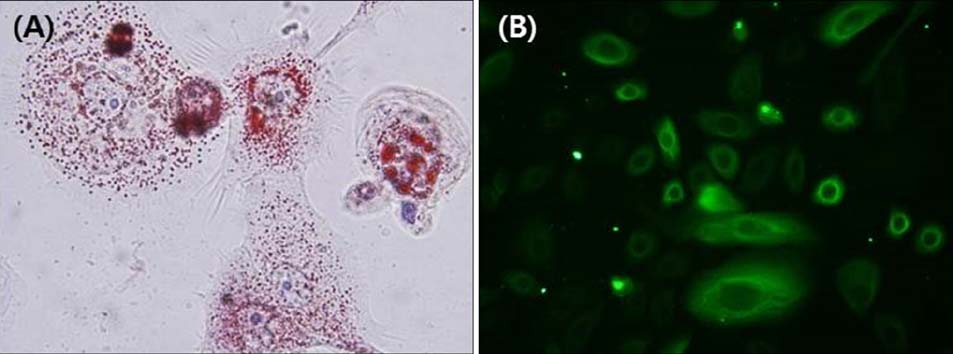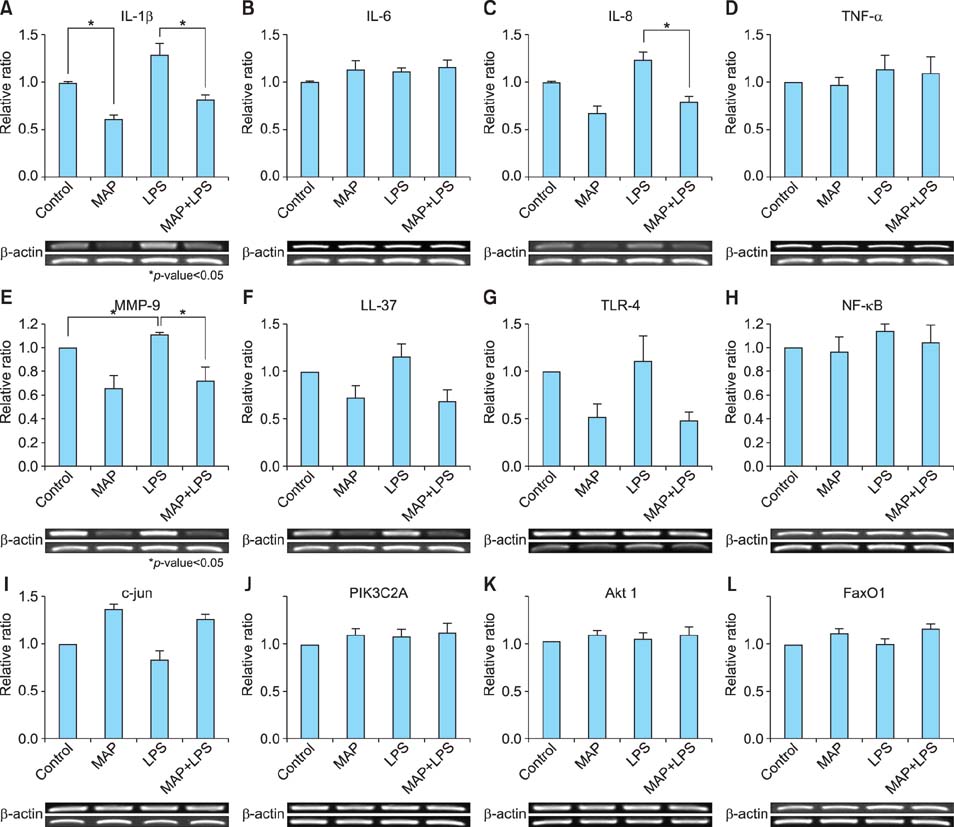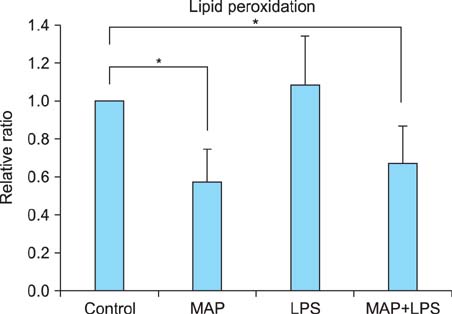Ann Dermatol.
2015 Aug;27(4):376-382. 10.5021/ad.2015.27.4.376.
Magnesium Ascorbyl Phosphate Regulates the Expression of Inflammatory Biomarkers in Cultured Sebocytes
- Affiliations
-
- 1Department of Dermatology, Kyungpook National University School of Medicine, Daegu, Korea. weonju@knu.ac.kr
- 2Park & Lee Skin Clinic, Daegu, Korea.
- KMID: 2171492
- DOI: http://doi.org/10.5021/ad.2015.27.4.376
Abstract
- BACKGROUND
Acne is an inflammatory skin disorder caused by inflammatory biomarkers. Magnesium ascorbyl phosphate (MAP) is a stable precursor of vitamin C. It achieves a constant delivery of vitamin C into the skin and has antioxidative effects.
OBJECTIVE
We performed this study to evaluate the effect of MAP on the expression of inflammatory biomarkers in cultured sebocytes.
METHODS
Reverse transcription-polymerase chain reaction (RT-PCR) and enzyme-linked immunosorbent assay were performed for inflammatory cytokines and matrix metalloproteinases (MMPs) before and after treatment of cultured sebocytes with MAP (10(-2) M), lipopolysaccharide (LPS) (5 microg/ml) and a combination of MAP and LPS. RT-PCR and western blotting were also performed for antimicrobial peptides (AMPs) and Toll-like receptor (TLR)-4 before and after treatment of cultured sebocytes with MAP, LPS, and a combination of MAP and LPS. Quantification of lipid peroxidation was also conducted.
RESULTS
The increased expression of inflammatory cytokines after treatment of cultured sebocytes with LPS was decreased after treatment with MAP. MMPs, AMPs, and TLR-4 were decreased after treatment of cultured sebocytes with MAP and a combination of MAP and LPS, and increased after treatment of cultured sebocytes with LPS alone. Lipid peroxidation was significantly decreased after treatment of cultured sebocytes with MAP and a combination of MAP and LPS. MAP decreased the increased lipid peroxidation after treatment of cultured sebocytes with LPS.
CONCLUSION
MAP may be an effective alternative agent to improve inflammatory reactions in acne.
MeSH Terms
-
Acne Vulgaris
Ascorbic Acid
Biomarkers*
Blotting, Western
Cytokines
Enzyme-Linked Immunosorbent Assay
Lipid Peroxidation
Lipopolysaccharides
Magnesium*
Matrix Metalloproteinases
Peptides
Skin
Toll-Like Receptors
Ascorbic Acid
Cytokines
Lipopolysaccharides
Magnesium
Matrix Metalloproteinases
Peptides
Toll-Like Receptors
Figure
Cited by 1 articles
-
Anti-Inflammatory and Antioxidative Effects of Alpha Lipoic Acid on Cultured Human Sebocytes
Weon Ju Lee, Dong Hyuk Eun, Seok Min Kim, Jun Young Kim, Yong Hyun Jang, Seok-Jong Lee
Ann Dermatol. 2019;31(1):84-87. doi: 10.5021/ad.2019.31.1.84.
Reference
-
1. Winston MH, Shalita AR. Acne vulgaris. Pathogenesis and treatment. Pediatr Clin North Am. 1991; 38:889–903.
Article2. Zouboulis CC. Acne and sebaceous gland function. Clin Dermatol. 2004; 22:360–366.
Article3. Zouboulis CC, Adjaye J, Akamatsu H, Moe-Behrens G, Niemann C. Human skin stem cells and the ageing process. Exp Gerontol. 2008; 43:986–997.
Article4. Park YK, Chung WS, Lee H, Jung SW. Whitening effect of cosmetics containing magnesium l-ascorbyl-2-phosphate (VC-PMG, vitamin C derivatives) assessed by colorimeter. Ann Dermatol. 2002; 14:63–70.
Article5. Alestas T, Ganceviciene R, Fimmel S, Müller-Decker K, Zouboulis CC. Enzymes involved in the biosynthesis of leukotriene B4 and prostaglandin E2 are active in sebaceous glands. J Mol Med (Berl). 2006; 84:75–87.
Article6. Corbel M, Theret N, Caulet-Maugendre S, Germain N, Lagente V, Clement B, et al. Repeated endotoxin exposure induces interstitial fibrosis associated with enhanced gelatinase (MMP-2 and MMP-9) activity. Inflamm Res. 2001; 50:129–135.
Article7. Iwata C, Akimoto N, Sato T, Morokuma Y, Ito A. Augmentation of lipogenesis by 15-deoxy-Delta12,14-prostaglandin J2 in hamster sebaceous glands: identification of cytochrome P-450-mediated 15-deoxy-Delta12,14-prostaglandin J2 production. J Invest Dermatol. 2005; 125:865–872.
Article8. Kim J. Review of the innate immune response in acne vulgaris: activation of Toll-like receptor 2 in acne triggers inflammatory cytokine responses. Dermatology. 2005; 211:193–198.
Article9. Nagy I, Pivarcsi A, Kis K, Koreck A, Bodai L, McDowell A, et al. Propionibacterium acnes and lipopolysaccharide induce the expression of antimicrobial peptides and proinflammatory cytokines/chemokines in human sebocytes. Microbes Infect. 2006; 8:2195–2205.
Article10. Oeff MK, Seltmann H, Hiroi N, Nastos A, Makrantonaki E, Bornstein SR, et al. Differential regulation of Toll-like receptor and CD14 pathways by retinoids and corticosteroids in human sebocytes. Dermatology. 2006; 213:266.
Article11. Triantafilou M, Triantafilou K. The dynamics of LPS recognition: complex orchestration of multiple receptors. J Endotoxin Res. 2005; 11:5–11.
Article12. Bojar RA, Holland KT. Acne and Propionibacterium acnes. Clin Dermatol. 2004; 22:375–379.
Article13. Böni R, Nehrhoff B. Treatment of gram-negative folliculitis in patients with acne. Am J Clin Dermatol. 2003; 4:273–276.
Article14. Zhou BR, Zhang JA, Zhang Q, Permatasari F, Xu Y, Wu D, et al. Palmitic acid induces production of proinflammatory cytokines interleukin-6, interleukin-1β, and tumor necrosis factor-α via a NF-κB-dependent mechanism in HaCaT keratinocytes. Mediators Inflamm. 2013; 2013:530429.15. Neely AN, Clendening CE, Gardner J, Greenhalgh DG, Warden GD. Gelatinase activity in keloids and hypertrophic scars. Wound Repair Regen. 1999; 7:166–171.
Article16. Papakonstantinou E, Aletras AJ, Glass E, Tsogas P, Dionyssopoulos A, Adjaye J, et al. Matrix metalloproteinases of epithelial origin in facial sebum of patients with acne and their regulation by isotretinoin. J Invest Dermatol. 2005; 125:673–684.
Article17. Tanriverdi-Akhisaroglu S, Menderes A, Oktay G. Matrix metalloproteinase-2 and -9 activities in human keloids, hypertrophic and atrophic scars: a pilot study. Cell Biochem Funct. 2009; 27:81–87.
Article18. Akitomo Y, Akamatsu H, Okano Y, Masaki H, Horio T. Effects of UV irradiation on the sebaceous gland and sebum secretion in hamsters. J Dermatol Sci. 2003; 31:151–159.
Article
- Full Text Links
- Actions
-
Cited
- CITED
-
- Close
- Share
- Similar articles
-
- Effects of Magnesium Ascorbyl Phosphate on the Expression of Inflammatory Biomarkers after Treatment of Cultured Sebocytes with Propionibacterium acnes or Ultraviolet B Radiation
- Insulin-Like Growth Factor-1 Increases the Expression of Inflammatory Biomarkers and Sebum Production in Cultured Sebocytes
- Effects of Black Ginseng Water Extract under the Inflammatory Conditions of Cultured Sebocytes and Outer Root Sheath Cells
- Dieckol Inhibits the Effects of Particulate Matter 10 on Sebocytes, Outer Root Sheath Cells, and Cutibacterium Acnes−Pretreated Mice
- Inflammatory Cytokine Expression and Sebum Production after Exposure of Cultured Human Sebocytes to Ultraviolet A Radiation and Light at Wavelengths of 650 nm and 830 nm





